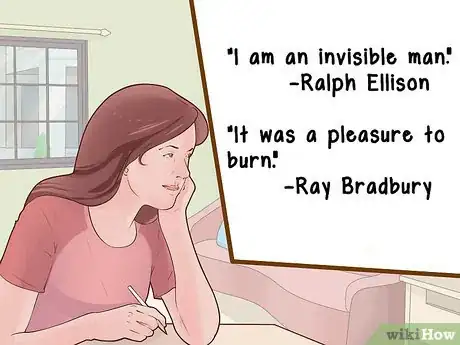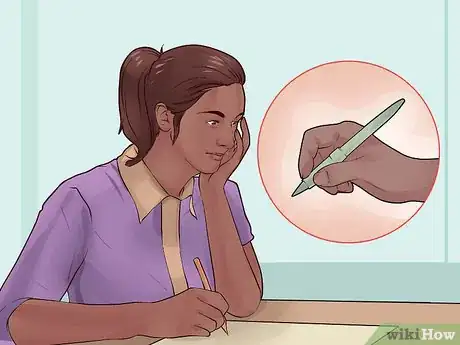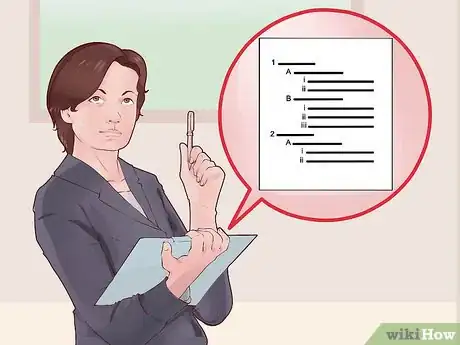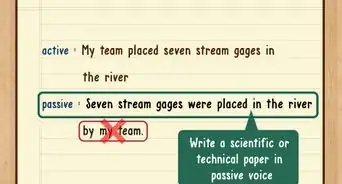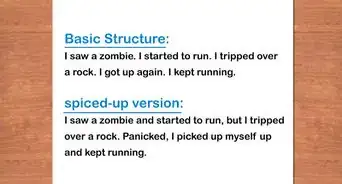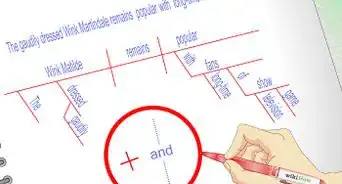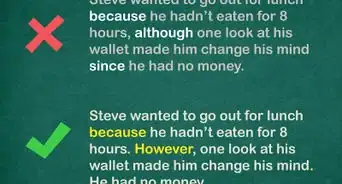This article was co-authored by Christopher Taylor, PhD. Christopher Taylor is an Adjunct Assistant Professor of English at Austin Community College in Texas. He received his PhD in English Literature and Medieval Studies from the University of Texas at Austin in 2014.
There are 14 references cited in this article, which can be found at the bottom of the page.
wikiHow marks an article as reader-approved once it receives enough positive feedback. In this case, 81% of readers who voted found the article helpful, earning it our reader-approved status.
This article has been viewed 65,212 times.
If you're a writer, you've probably dreamed of completing your first book. But once you've decided to actually write a book, how do you get started? Staring at a blank page or screen can be daunting. That's why many writers don't actually start with their first sentence. Instead, they give themselves time to get to know their characters and story. Whether you start or end your writing process with your first sentence, with a little planning and preparation you'll be ready to crank out the pages in no time.
Steps
Finding Ways to Write Your First Sentence
-
1Begin with an aphoristic observation. Many classic novels open with a universal truth being mused over by the narrator. Think about what your novel is about. Is it addressing family relations? Personal struggles? A person's capacity to be his/her own downfall?[1]
- Once you've narrowed down the larger issue(s) at play in your novel, you can begin to think about that issue in a more poetic way. Try to arrive at some type of universal truth on your subject. If you can't come up with your own, you can always quote a famous aphorism.
- For example, Anna Karenina by Leo Tolstoy begins with the line, “Happy families are all alike; every unhappy family is unhappy in its own way.”
- For inspiration or to find a strong aphorism you can quote, try searching online. You might start with MIT's compilation of Hippocrates's aphorisms, which can be found at http://classics.mit.edu/Hippocrates/aphorisms.html.
-
2Start with a concise statement of truth. If aphoristic observations don't fit with your narrator's voice, you might try opening with a concise statement from the narrator. This statement should reveal a deep truth about your character and the way they perceive their world. Many classic novels open this way, including Ralph Ellison's Invisible Man ("I am an invisible man.") and Ray Bradbury's Fahrenheit 451 ("It was a pleasure to burn.").[2]
- Think about what kind of personality your narrator has. Delve deep into his biggest triumphs, his greatest struggles, and his ultimate downfall (if he has one).
- Put yourself in your narrator's shoes. How might he/she bring a reader up to speed in one or two concise, all-encompassing sentences?
- It may be helpful to imagine yourself as the narrator having a conversation with an unseen partner, perhaps over coffee or drinks. What would your narrator say in a moment of absolute truth that would make for a jumping off point in your story?
Advertisement -
3Open with a deceptively complex statement. Some authors of well-known novels have chosen to begin their books with a simple fact that carries a larger significance. Try to start with an observation that appears simple on the surface, but after the reader has finished the novel it will become clear that this sentence carries a lot more weight than it seemed.[3]
- An example of this can be found in the opening of F. Scott Fitzgerald's The Great Gatsby, which begins "In my younger and more vulnerable years my father gave me some advice that I've been turning over in my mind ever since. 'Whenever you feel like criticizing anyone,' he told me, 'just remember that all the people in this world haven't had the advantages that you've had.'"
- This type of opening line may work best if you finish a draft of your novel, then return to rewrite the beginning during the revision process. You'll need to know what happens and how each character develops on the page in order to give a meaningful, complex statement in the opening line.
- As you read through the first draft of your novel, think to yourself, "Where does the key to the main character's psyche, struggle, or ultimate victory lie?"
-
4Use the first line to establish an element. A classic strategy for writing the first line of a book is to establish some literary element that will carry the reader into the narrative. You can use the opening line to establish the mood of the book, introduce the narrator's voice (or a main character's voice), or frame the time and place in which the book takes place.[4]
- There's no right or wrong method here. You may have to play with different establishing elements until you find the one that works best for your book.
- Think about what would work best to orient the reader into your book and go from there.
- Look at Mark Twain's The Adventures of Huckleberry Finn for an example. It starts "You don't know about me without you have read a book by the name of 'The Adventures of Tom Sawyer', but that ain't no matter."
Beginning a Novel
-
1Choose an inciting incident. Most novels involve some type of inciting incident - an occurrence or situation that sets the novel's action in motion. Whether or not the inciting incident takes place in the opening sentences of a novel, the beginning of the book should set up the incident that will propel the remainder of the narrative.[5]
- An inciting incident should establish the main character's initial, "surface-level" problem. That problem will end up setting the stage for the larger issues that the character struggles with throughout the novel.
- No matter what the final outcome of your novel will be, the main character should struggle and fail to overcome his initial surface problem. If it were a problem he could overcome with ease, there would be no novel beyond that inciting incident.
- Whatever actions the main character (and the supporting characters) takes to resolve the initial problem should be a flawed action. Whether it's a failure of the character's ethics, or simply a circumstance that is larger than she realizes, she must struggle and set up future problems that will be addressed in the novel.
- An example of this can be found in Franz Kafka's The Metamorphosis, which starts "As Gregor Samsa awoke from a night of uneasy dreaming, he found himself transformed in his bed into a gigantic insect."
-
2Decide how to introduce the characters. The first chapter of a novel should at least introduce the main character, if not other characters as well. However, how you introduce that character (and any supporting characters) can mean the difference between a natural progression of events and a jarring intrusion in the narrative.
- Don't front-load a character's backstory. If you're giving the character's life history before you've even established the plot, readers will get confused or turned off by the novel.
- Remember to make your characters believable. Don't try to write a hero who is always absolutely good or a villain who is always absolutely evil - no one in real life can be defined this way, so your characters shouldn't be either.[6]
-
3Think about how to orient the reader. The beginning of a novel serves as a sort of orientation for the reader. It should seize the reader's attention, drop her (either abruptly or gradually) into the setting and mood of the narrative, and/or introduce at least the main character.[7] There are a number of ways to do this, and the choice ultimately lies in your tastes and what you think will best set up your story.
- Beginning with a description of a scene or a character is a common way to start a novel. But long-winded descriptions can easily bore a reader, especially if she isn't already invested in the novel.
- Opening with a piece of dialogue is a good way to introduce the main character and show how she interacts with others (which can be very revealing). However, dialogue can be tricky, and opening the book with dialogue could turn off readers who don't like the way the character speaks.
- Many novels begin "in medias res," a Latin term meaning "in the middle of things." This means starting the book somewhere in the middle of the action that would otherwise take a few chapters to unfold and build up to.[8]
-
4Put it all together. Once you've outlined the main character's personality, the inciting incident, and how to orient the reader in your novel, you'll need to put it all together. This is where you stop planning and start actually writing the first sentence of your novel.
- Don't be afraid to try different approaches. Write your first sentence a few different ways (in medias res, opening with description, etc.) and see what feels most natural for you and most appropriate for your story.
- Try not to let this step intimidate you. Remember that you will go back and edit, revise, or cut scenes out entirely - but you can only make changes once you've actually put your pen to the page (or started typing out on the keyboard).
- In fact, your first try at your first sentence probably won't be the one that makes it to your final draft. Your first sentence will likely change as your story and characters develop. Start with a sentence to get you started, and revise it later to give your story more of a hook.
-
5Write the last sentence of the first chapter. It may sound strange that starting a book from the first sentence should require an ending to the first chapter. But some experts advise that it can help you stay on track and find some sense of direction for each chapter, including the very beginning of your novel.[9]
- Think of each chapter as a journey from point A to point B.
- Your first sentence, which you now have, is point A. Without a point B in mind, you could end up wandering aimlessly and forget what you intended for that chapter to accomplish.
- You can always change the last sentence once you get to the end of the chapter. The point is to give yourself some type of concrete end-point to work towards.
Starting a Nonfiction Book
-
1Choose a form. Nonfiction is a broad genre, covering anything that is not made up. That can include memoir, personal essays, a history book, a cook book, self-help guides, and even travel guides.[10] Before you start writing a nonfiction book, you should have a pretty good idea of what kind of book you're hoping to write.
- Personal essays are often reflective/meditative, and can deal with past or current events in your life. An essay should explore a topic or event thoroughly, examining it from all angles and looking past the surface of things.[11]
- Memoir tends to contextualize a singular event or situation from the past, analyzing it with new insight from the present. Memoirs often address why an event was significant, what it meant at the time for the writer, and why it's important to her now.[12]
- Instructive books, such as travel guides, self-help books, and cook books, tend to be equal parts research and instruction. You'll need to know what you're talking about (with credible, authoritative sources) and you'll need to be able to tell a reader what to do and when to do it.
- History books require extensive research, and often need some type of authority on the part of the author. If you don't have a degree in history, readers may question why you're qualified to write about historical events.
-
2Figure out your end point. Just as a novel requires the author to know where her book is leading, so too does a nonfiction book. Without knowing what your narrative is leading up to, you risk rambling aimlessly trying to get there.
- Figure out your nonfiction book's narrative arc. What is everything building towards, and what information/details are necessary to carry a reader along to that point?
- Break down your narrative into a series of events and the complications that surround each event. For example, one event in your book might be your birthday party, and the complication might be that your parents forgot it was your birthday.
- Each action, obstacle, and person described in the book should contribute towards the book's endpoint. If they're not relevant, no matter how interesting they might be, you may need to cut them out.[13]
-
3Start writing. Unlike a novel, you can't just create characters and scenes in your head. Nonfiction requires the people and experiences to be real, and the dialogue should be as true as possible (taking into account the limiting factor of memory). How you decide to begin your nonfiction book should be a natural starting point for the true story you're trying to tell.
- Just like a novel, a narrative nonfiction book (specifically a memoir or essay collection) should have some type of initiating incident. You can't make up the incident as you would in fiction, so figure out what event really set your life up for the larger events your book is about.
- Starting the book with the initiating incident, or even beginning it in medias res, can hook your reader with the intensity of the actions or tragedy that occurred in your life.
- Many nonfiction books begin with what's called a status quo scene: a depiction of what the described world looked like before the initiating incident. It's a good way to draw a reader in because they know that something will inevitably shake up the setting, which provides motivation to keep reading.[14]
-
4Open with a concise fact that establishes the meaning of your writing. Many nonfiction books, especially those that have more of an academic underpinning, start with a simple statement of fact. This fact should have a clear meaning to your readers so that they understand from the beginning why your book is significant.
- In some cases, the fact may stand alone. If you're writing a true crime novel, you may start with, "In just 2 years, Vasili Komaroff managed to kill 33 innocent men." This doesn't need to be explained further, as in most places murder is socially taboo.
- In other cases, you may have to provide context to establish significance. For example, if you're writing about the of the decline of the Silk Road you may say, "Before the Mongol attacked, Merv was the Silk Road's most populous stop as a city with over a million people." In this case, it's necessary to give context to how big the city was, since it's not common knowledge.
-
5Keep your perspective in check. It goes without saying that a memoir or personal essay collection will be told from your point of view. Everything that happens in the book should have happened to you, and you're obligated to tell those stories as completely and truthfully as possible. However, many people have a hard time keeping their personal perspective in check while writing about real-life events. Everyone experiences an event differently, and everyone will have a differing perspective about the details of what happened, so tread carefully as you write about your life and the people/events in it.
- Don't write yourself as a hero or a victim. Even if you feel that way, it will be clear to the reader that there are things being withheld, or it might turn readers off altogether.
- Remember that you're just like everyone else: a real, living, slightly flawed human being. You're not perfect, and the people in your life are not objectively bad or malicious.
- Everything requires balance in storytelling. Even if your memoir is about your troubled childhood, no reader will believe that you were unhappy 24/7, so balance those heartbreaking moments of tragedy with some lighter moments that depict your best days side-by-side with your worst.[15]
Planning Out the Rest of Your Book
-
1Decide what your book is about. Before you begin any writing project, it's important to have a firm idea in mind of what you're writing about. This may sound obvious, but it's an important part of planning out any book-length project. Your opening sentence should relate tightly to this, and be connected to the themes, structures, and purposes that you establish here.
- Know the story you want to tell.
- Decide which characters (real life people or invented, fictional characters) are relevant.
- Recognize what the crisis is in your story - and every story needs some type of crisis.
- Remember that every good story, whether fiction or nonfiction, should include some type of discovery/revelation that leads to some kind of subsequent change.[16]
-
2Outline everything. Some writers feel that an outline is too restrictive. While that may be true for some people, many writers can easily get off track without an outline. You risk rambling and going on irrelevant tangents, or even forgetting to include some pertinent detail or event. A good outline should include:
- a solid understanding of your subject
- the narrative arc of your book (what everything is building towards)
- the primary setting of each scene
- the characters involved (whether real or imagined)
- what each scene or chapter is attempting to accomplish (within the context of your narrative arc)[17]
-
3Make every sentence relevant. Some beginning authors try to make the first chapter a prologue, or spend page after page describing a scene/landscape. Others try to use a false beginning, like a dream sequence that feels real. However, literary agents and audiences alike often feel unsatisfied or even cheated by these beginnings. Instead of relying on tricks or artifice, make every page relevant, engaging, and well-written.[18]
- Avoid tangential or irrelevant descriptions. Remember the piece of advice Anton Chekhov shared: if you put a loaded gun in a scene, it must go off.[19]
- Cut down on unnecessary descriptions by omitting needless adverbs and adjectives. If the reader can get an image of what you're describing from the nouns and verbs (and some limited adjectives), an adverb describing the verb is probably unnecessary.[20]
- Remember the old adage, "Show, don't tell" - in other words, depict the scene, person, or action, rather than telling the reader about it.
- Remember that not every single landscape, building, person, and action need a lot of showing. Focus on what's important and let the reader's imagination fill in the rest.
Expert Q&A
-
QuestionHow do you start a book?
 Christopher Taylor, PhDChristopher Taylor is an Adjunct Assistant Professor of English at Austin Community College in Texas. He received his PhD in English Literature and Medieval Studies from the University of Texas at Austin in 2014.
Christopher Taylor, PhDChristopher Taylor is an Adjunct Assistant Professor of English at Austin Community College in Texas. He received his PhD in English Literature and Medieval Studies from the University of Texas at Austin in 2014.
English Professor To begin writing a book, you need a strong first sentence. This article provides strategies for writing that first sentence, including offering an aphoristic observation, declaring a concise statement of truth, presenting the reader with an engima, or establishing a clear point of view, tone, or methodology. Writing an effective first sentence can provide momentum and focus to your writing efforts.
To begin writing a book, you need a strong first sentence. This article provides strategies for writing that first sentence, including offering an aphoristic observation, declaring a concise statement of truth, presenting the reader with an engima, or establishing a clear point of view, tone, or methodology. Writing an effective first sentence can provide momentum and focus to your writing efforts. -
QuestionWhat is the opening sentence?
 Christopher Taylor, PhDChristopher Taylor is an Adjunct Assistant Professor of English at Austin Community College in Texas. He received his PhD in English Literature and Medieval Studies from the University of Texas at Austin in 2014.
Christopher Taylor, PhDChristopher Taylor is an Adjunct Assistant Professor of English at Austin Community College in Texas. He received his PhD in English Literature and Medieval Studies from the University of Texas at Austin in 2014.
English Professor The opening sentence is simply the first sentence of your book. It doesn't necessarily have to be the first sentence you write, however; you can write the opening sentence after you've developed the characters and plot.
The opening sentence is simply the first sentence of your book. It doesn't necessarily have to be the first sentence you write, however; you can write the opening sentence after you've developed the characters and plot. -
QuestionHow do you start an opening sentence in an essay?
 Christopher Taylor, PhDChristopher Taylor is an Adjunct Assistant Professor of English at Austin Community College in Texas. He received his PhD in English Literature and Medieval Studies from the University of Texas at Austin in 2014.
Christopher Taylor, PhDChristopher Taylor is an Adjunct Assistant Professor of English at Austin Community College in Texas. He received his PhD in English Literature and Medieval Studies from the University of Texas at Austin in 2014.
English Professor The purpose of an opening sentence in an essay depends on the genre of the essay, but in general, you want to find a "hook" that interests readers and leads them toward the main topic of your essay.
The purpose of an opening sentence in an essay depends on the genre of the essay, but in general, you want to find a "hook" that interests readers and leads them toward the main topic of your essay.
References
- ↑ http://www.writersdigest.com/online-editor/7-ways-to-create-a-killer-opening-line-for-your-novel
- ↑ http://www.writersdigest.com/online-editor/7-ways-to-create-a-killer-opening-line-for-your-novel
- ↑ http://www.writersdigest.com/online-editor/7-ways-to-create-a-killer-opening-line-for-your-novel
- ↑ http://www.writersdigest.com/online-editor/7-ways-to-create-a-killer-opening-line-for-your-novel
- ↑ http://www.writersdigest.com/editor-blogs/there-are-no-rules/write-fiction-that-grabs-readers-from-page-one
- ↑ http://thewritelife.com/the-worst-ways-to-begin-your-novel-advice-from-literary-agents/
- ↑ http://www.writersdigest.com/online-editor/the-5-essential-story-ingredients
- ↑ https://andromeda.rutgers.edu/~jlynch/Terms/inmediasres.html
- ↑ http://www.writersdigest.com/online-editor/how-to-write-a-manuscript-5-excellent-tips
- ↑ http://www.writersdigest.com/writing-articles/by-writing-genre/nonfiction-by-writing-genre
- ↑ http://www.writersdigest.com/editor-blogs/there-are-no-rules/how-to-write-a-reader-friendly-essay
- ↑ https://owl.english.purdue.edu/owl/resource/753/02/
- ↑ http://www.writersdigest.com/writing-articles/by-writing-goal/improve-my-writing/elements-of-an-effective-arc
- ↑ https://owl.english.purdue.edu/owl/resource/753/02/
- ↑ http://www.writersdigest.com/tip-of-the-day/focus-on-the-memoir-essay
- ↑ http://www.writersdigest.com/online-editor/the-5-essential-story-ingredients
- ↑ http://www.writersdigest.com/whats-new/choosing-the-best-outline-method-for-you
- ↑ http://thewritelife.com/the-worst-ways-to-begin-your-novel-advice-from-literary-agents/
- ↑ https://www.writingclasses.com/toolbox/ask-writer/whats-this-business-about-chekhovs-gun
- ↑ http://www.writersdigest.com/writing-articles/by-writing-goal/write-first-chapter-get-started/nobles-writing-blunders-excerpt

